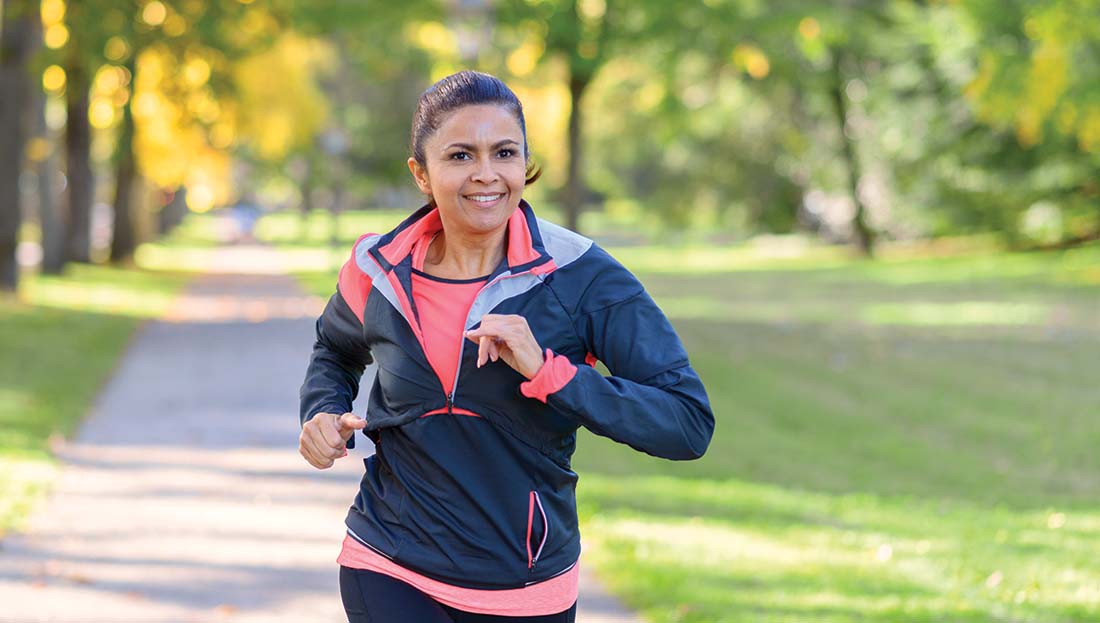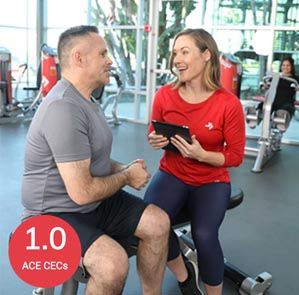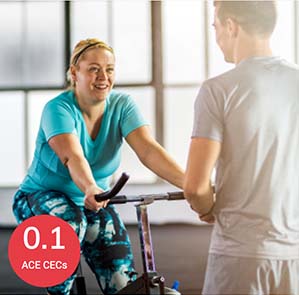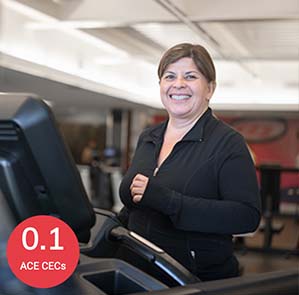
It’s no secret that exercise can help prevent chronic diseases, but an increasing body of evidence suggests that exercise can be an important part of treatment plans to improve various health issues such as depression, fatty liver disease and metabolic syndrome. It’s also been shown to help increase insulin sensitivity and improve blood sugar levels in those with type 2 diabetes.
It is estimated that more than 50% of adults in the United States have impaired insulin sensitivity, and for many of them it’s only a matter of time before developing type 2 diabetes. This article examines the current research on exercise and insulin sensitivity and looks at how health and exercise professionals can work with a client’s healthcare team to maximize the benefits of physical activity to increase their insulin resistance.
Research Review: Exercise and Insulin Sensitivity
A 2021 meta-analysis suggests that resistance training is effective for improving insulin sensitivity in older adults. These findings echoed previous studies, including a 2018 meta-analysis in which researchers noted that “the evidence highlights the effectiveness of a structured exercise intervention program for insulin resistance in [individuals with type 2 diabetes].”
The consensus is that exercise can improve insulin resistance, and some research suggests that it may help some people reduce their reliance on medication to manage their type 2 diabetes. For example, a March 2020 review found that “exercise was associated with discontinuation of glucose-lowering medication in a dose-dependent manner.” If you have clients who have been diagnosed with type 2 diabetes, you are in a position to work in partnership with their medical care team to monitor blood sugar, A1C (a blood test that measures average blood sugar levels for the past three months), body composition and triglyceride levels.
A word of caution: As a health and exercise professional, you should never attempt to treat medical conditions; rather, your role is to work alongside a client’s medical care team and help them to utilize exercise as a tool to improve insulin resistance. Anyone experiencing insulin resistance should always maintain close contact with their medical care team.
Exactly How Does Exercise Improve Insulin Resistance?
Signs of Insulin Resistance
While blood tests are used to determine if someone has prediabetes, specific tests for determining if someone has insulin resistance are complicated and often only used for research purposes. In many cases, there are no symptoms. Insulin resistance occurs due to excess weight, especially visceral fat in the abdomen, and has been linked to inactivity.
According to the National Institute of Diabetes, the following are considered risk factors for insulin resistance:
- Having overweight or obesity
- Being age 45 or older
- Having a parent, brother or sister with diabetes
- Being of African American, Alaska Native, American Indian, Asian American, Hispanic/Latino, Native Hawaiian, or Pacific Islander American descent
- Being physically inactive
- Having a history of gestational diabetes
- Having a history of heart disease or stroke
- Having high blood pressure levels
- Having abnormal cholesterol levels
- Having polycystic ovary syndrome
Encouraging clients to stay current with their annual physicals and preventive lab work can help them to monitor trends over time. In some cases, especially following a type 2 diabetes diagnosis, a client may also be in contact with a medical specialist, a diabetes health educator and/or a dietitian.
Insulin, which is made by the pancreas, regulates blood sugar. Insulin is the “key” that allows glucose to be utilized as fuel by the body. In the case of insulin resistance (which can lead to prediabetes or type 2 diabetes), the body does not effectively utilize insulin and, as a result, can’t use the glucose. This causes the pancreas to make more insulin—which the body eventually becomes resistant to—and eventually causes glucose to build up in the bloodstream, causing high blood sugar. Over time, this leads to type 2 diabetes.
Exercise can help with insulin resistance in a few ways. In the short term, during low- to moderate-intensity exercise, muscles utilize glucose from the bloodstream; this “clears out” the excess glucose from the blood stream and allows it to be utilized. In the long term, a consistent exercise program increases insulin sensitivity and can reduce A1C levels.
An intense workout can increase glucose levels for a short duration due to the hormones released (specifically adrenaline). However, the glucose is utilized once the workout is over.
Increasing muscle mass can also improve the body’s ability to utilize glucose and maintain homeostasis because muscles use much of the body’s glucose. One study uncovered a link between a reduction in muscle mass due to aging and insulin resistance. This suggests that incorporating resistance training and increasing muscle mass can help your clients, particularly those who are older, reduce their insulin resistance.
If Exercise is Medicine, What is the Dose?
Medications are prescribed in specific doses, so what is the dose of exercise that can treat or improve insulin resistance? Any amount of exercise can be helpful, but the American College of Sport Medicine (ACSM) recommends the following:
- Aerobic exercise: Three to seven days per week for a total of 150 minutes at a moderate-to-vigorous intensity with no more than two consecutive days without activity
- Resistance training: Two to three nonconsecutive days per week at a moderate [50 to 69% of one-repetition maximum (1-RM)] to vigorous (70 to 85% of 1-RM) intensity; eight to 10 exercises performed for one to three sets of 10 to 15 repetitions to near fatigue per set involving major muscles groups
- Flexibility and balance training: At least two to three days per week of stretching to a point of tightness or slight discomfort; light-to-moderate intensity balance exercises
Early in 2022, the ACSM updated their 2010 consensus statement on exercise and physical activity in individuals with type 2 diabetes to include the following key points:
- Exercising after meals reduces blood glucose levels regardless of the intensity or type of activity performed and exercising for 45 minutes or more provides the most consistent benefits.
- Small “doses” of any physical activity done throughout the day to break up sedentary time can help lower glucose and insulin levels after meals. This reduction is modest, however, particularly in individuals with insulin resistance and a higher body mass index (BMI).
- Weight loss—when accomplished through lifestyle changes in diet and activity—of more than 5% of total body weight seems to be necessary for the most beneficial effects on A1C, blood lipids and blood pressure in adults with type 2 diabetes.
- The joint statement emphasizes the importance of combining cardio and resistance training, stating that performing both brings about the greatest reduction in markers related to type 2 diabetes and insulin resistance. Some individuals may benefit from combining aerobic training and resistance training in one workout using circuit workouts. Body-weight circuits may be helpful for clients working up to being able to utilize free weights.
Coaching to Improve Insulin Resistance
Don’t Forget Your OARS
The OARS of motivational interviewing is a great technique for getting to the heart of a client’s internal motivation:
O: Open-ended questions allow clients to tell their story.
- Help me understand…
- What has helped you to be successful in the past?
- How would you like things to be different?
A: Affirmations are statements that recognize client strengths or wins.
- I appreciate your willingness to open up about …
- That’s a great suggestion.
- Thank you for being on time and ready to go for our session today.
R: Reflection or reflective listening shows you understand what the client is sharing and can build trust. This can be done by repeating back what the client is saying, asking clarifying questions or reflecting the emotion the client is feeling.
- It sounds like you…
- So, you feel…
- You’re wondering if…
S: Summarizing what has just been said can be done a few times over the course of a session. Be sure to focus on where the client has indicated they want to change or are committed to making a change.
- Let me see if I understand so far…
- Let me know if I’m missing anything…
Keep in mind the following three considerations when working with a client to help them improve their insulin resistance:
1. While the guidelines are specific about exercise recommendations and “dose,” don’t give your client a program for which they aren’t yet ready. Starting with smaller bouts of exercise may be beneficial, with the goal of working toward meeting all guidelines over time.
The American Diabetes Association emphasizes the importance of decreasing sedentary behavior. Short walks, especially after a meal, can play a role in improving insulin resistance. For some clients, this habit may be easier to develop than going to the gym for longer periods of time, especially when they are first starting an exercise program.
Encourage your clients to utilize local resources such as parks and recreation programs, group fitness, hiking trails or public pools, which can help them reduce their sedentary behavior outside of their scheduled coaching or training sessions.
2. Start with the types of exercise your client enjoys the most. As a health and exercise professional, you are highly skilled in developing training plans, but if a client feels forced to do a workout they don’t enjoy, or feels a lack of confidence in the gym, the likelihood of the exercise habit sticking (and therefore having an impact on insulin resistance) is minimal.
Asking the client about a time in the past when they’ve felt successful with incorporating exercise can provide clues to what may be helpful or what they may enjoy now. Incorporating physical activities the client enjoys, while helping to build confidence and self-efficacy with new workouts, can help build momentum and results. It also increases the likelihood that they will stick with it. When a client associates positive feelings with their workout, they can gain self-efficacy and will be more likely to follow through on their training plan.
3. Build rapport and aim to understand the client’s motivation for wanting to change. A diagnosis or potential diagnosis may cause some clients to be motivated by fear to make positive lifestyle changes, but fear can only motivate for so long. Build connection and aim to understand what the client wants for their future (not just the illness they are trying to avoid). It’s a lot more fun to exercise with an exciting goal in mind than it is to exercise because of the fear of dying from a disease. If a client doesn’t have a specific goal in mind, using open-ended questions (see sidebar, "Don't Forget Your Oars") about imagining life in the next one year or five years can be an effective way to help them uncover what is meaningful to them.
Starting with small habits, aiming to have a positive experience while working out and getting clear on a goal or motivator can help a client be successful in meeting the exercise guidelines that have been shown to improve insulin resistance. While exercise is important in improving insulin resistance, combining physical activity with improved nutrition and behavior change coaching, while under the supervision of the medical care team, offers your clients the greatest opportunity to achieve optimal results.
Expand Your Knowledge
 |
This course reinforces your knowledge about healthy habits and equips you to coach clients using evidence-based disease-prevention strategies that address physical activity, nutrition and lifestyle behavior change together. Upon completion of this course, you will be well prepared to create and deliver diabetes prevention strategies, increasing your earning potential and expanding your impact by serving the growing number of people struggling with, or at risk, for diabetes.
|
 |
This course will teach you effective lifestyle behavior-change strategies to prevent and manage prediabetes and type 2 diabetes. By acquiring the knowledge to serve this specialized population, exercise professionals, health coaches and other allied health professionals can become a valuable addition to the diabetic client’s healthcare team.
|
 |
This video training offers research-based strategies for preventing and managing type 2 diabetes with exercise and covers which exercise programs are most effective to combat this silent killer. You’ll gain valuable insights and tools that you can put to work immediately with your clients who have diabeties or prediabetes.
|





 by
by 





